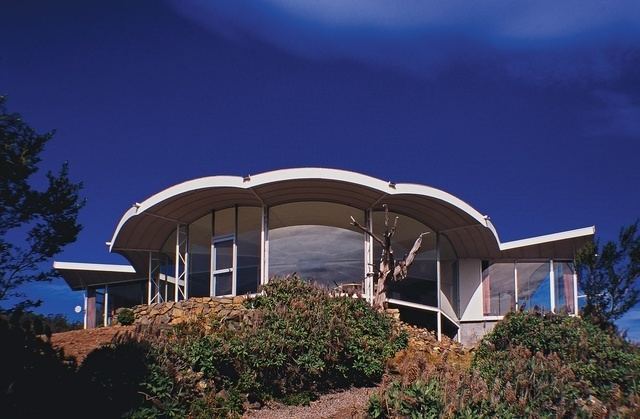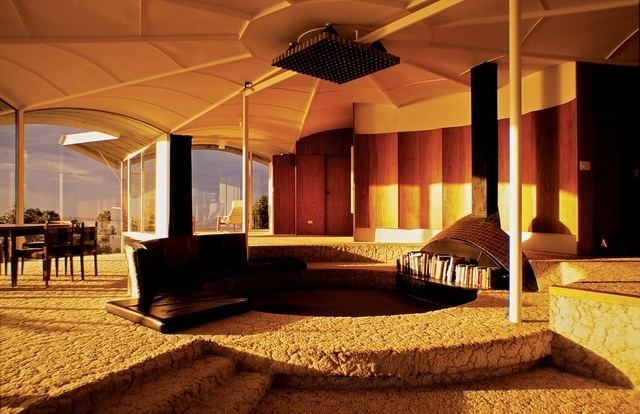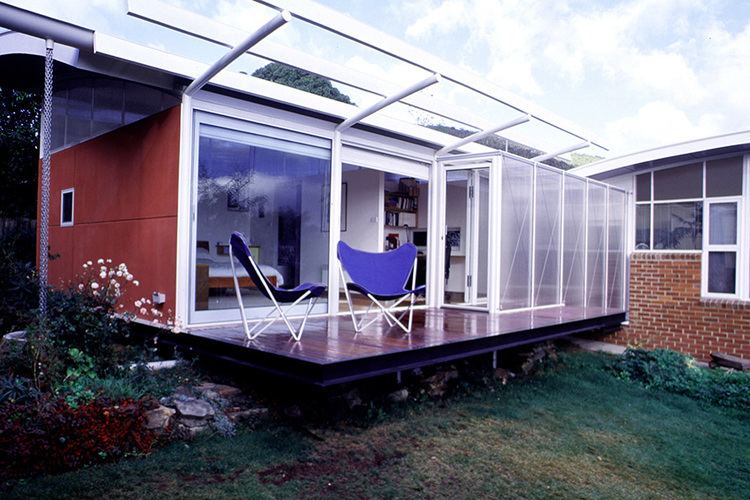Name Esmond Dorney | ||
 | ||
James Henry Esmond Dorney (17 September 1906 – 25 December 1991) was an Australian architect who is now gaining national and international attention.
Contents
- Early life
- World War II
- Post World War II
- Windermere
- The Young House
- Victoria
- Tasmania
- Posthumous recognition
- References

He was born to Marie Louise Kiernan and James Henry Dorney in Melbourne, Victoria and spent most of his teenage life at their family home in Elwood. Dorney was employed by Walter Burley Griffin before he started his own practice in 1930. After World War II, Esmond Dorney moved to Hobart and continued his practice until his death in 1991.

Early life

Dorney studied Architecture briefly at the University of Melbourne, however quickly became disenchanted by the course, dismissing it as ‘a meaningless pursuit of Classical Revival.’ He was later expelled for racing his Delage around the university campus, presumably without regret.

In the mid-1920s Dorney trained with Walter Burley Griffin and Marion Mahoney, architects of significant note in Australia and internationally, specifically Chicago. Though he learnt through them a respect for the landscape which became a valuable element of his style, particularly in the design of his own residence in Fort Nelson, Tasmania, he rejected the Prairie School aesthetic and upon that premise discontinued his training.

In 1929, at the age of 23 Dorney, drawing on his training with Walter Burley Griffin & Marion Mahoney and the engineering firm Johns & Waygood (to whom he attributed an ‘understanding of the capabilities of new technologies’), established his own practice just in time for the Great Depression. Many architectural firms in Melbourne failed in this period due to the economic recession, Dorney's practice thrived due to his celebration of new architectural approaches that supported the expanding interests of the growing middle class. Much of his pre war design is heritage listed, but the hiatus of WWII brought about a transformation in his approach to architecture. His post war work evolved his clear expression of the qualities and the possibilities of structure and materiality.
World War II

Esmond Dorney’s career as an architect was interrupted by World War 2, when he enlisted and served as a pilot in the Royal Air Force Volunteer Reserve from 1940-1945.
At the fall of Singapore, he was redeployed to Java and worked behind Japanese lines, establishing secret radar instillations. Spending some time in a POW camp, he eventually escaped and remained with Chinese guerillas until the end of the war. This period of forced design inactivity generated a revolution in his architecture.
Post World War II
Dorney returned to Australia, moving from his home in Melbourne to Hobart, Tasmania, citing health and personal reasons. Esmond Dorney enjoyed great success and status as a highly regarded modern architect nationally. His work maintains relevance and his continued influence on contemporary design is widely acknowledged. Notable examples of his post war modernist residences include his own houses at Fort Nelson, the Young House, the Dorney Shack (beach house), and the Richardson House.
Windermere
49 Broadway, Elwood.1936. Heritage listed very early for a modern building in Victoria, this celebrated block of flats in the moderne style is recognised for its elegant and eloquent address of the street and the off street articulation of the apartments and entrance facades that provides each with individual identity.
St Kiernan's Flats
51 Ormond Esplanade is one of the best surviving examples of Esmond Dorney’s interwar functionalist buildings. It was Constructed in 1939, Dorney worked extensively in this style prior to World War II.
One of a series of apartment projects designed by Esmond Dorney in Elwood between 1931 and 1939. As with their family home Chenier, which was converted to flats in 1934 and the Antigone flats at 34 Docker Street, Elwood. St Kiernan’s Flats as it was known, was designed for his mother Ms Marie Louise Dorney, née Kiernan. The moniker St Kiernan’s Flats (a reference to Dorney’s mother) was transferred to another development at 57 Ormond Esplanade in 1948.
The stark and solid geometry of 51 Ormond Esplanade is typical of inter war functionalist style, of which Dorney was particularly partial. This is also characterised by the rendered brick façade and the flat roof. The triple fronted façade is composed of a north and south wing and a projected central portion which acts as the main entrance. A large brick chimney climbs the central portion giving the building a strong vertical element. The building also features extensive use of ribbon windows that Dorney used favourably during his exploration of the functionalist style.
Llanhydroch (Now Dalcrombie)
Olinda, 1932–38
Long mis-attributed to Harry Norris, this building explored the functional capacity of steel and concrete through its massive cantilevers and the suspension of the entrance stair. Moderne, while evocative of Italian functionalism and the work of Nervi and Pagano.
The Young House
Designed in 1959 in the Hobart suburb of Sandy Bay the Young House is one of Dorney’s most acclaimed and widely celebrated residential projects. It is considered significant because of the way it describes the ‘formal and spatial’ qualities that Dorney has integrated into the design. It also demonstrates Dorney’s profound understanding of the nature, climate and prospect of its locality.
‘It is a prominent and historically important piece not just because it is Dorney’s most acclaimed work, but more significantly because of the understanding of the landscape of Hobart and the relationship to the site which is expressed in its structural and spatial organisation.’ -Morris-Nunn and Associates Architects, 536 Churchill Avenue Extension, Design Report.
Victoria
Tasmania
Posthumous recognition
In 2008 James Jones, president of the Tasmanian chapter of the Australian Institute of Architects posthumously awarded Esmond Dorney the 2008 President’s Prize, which was accepted by his son, Paddy Dorney, stating ‘Dorney returns us to the worth of the architecture, saying something about humanity, who we are through how we build and how we live in the landscape.’
